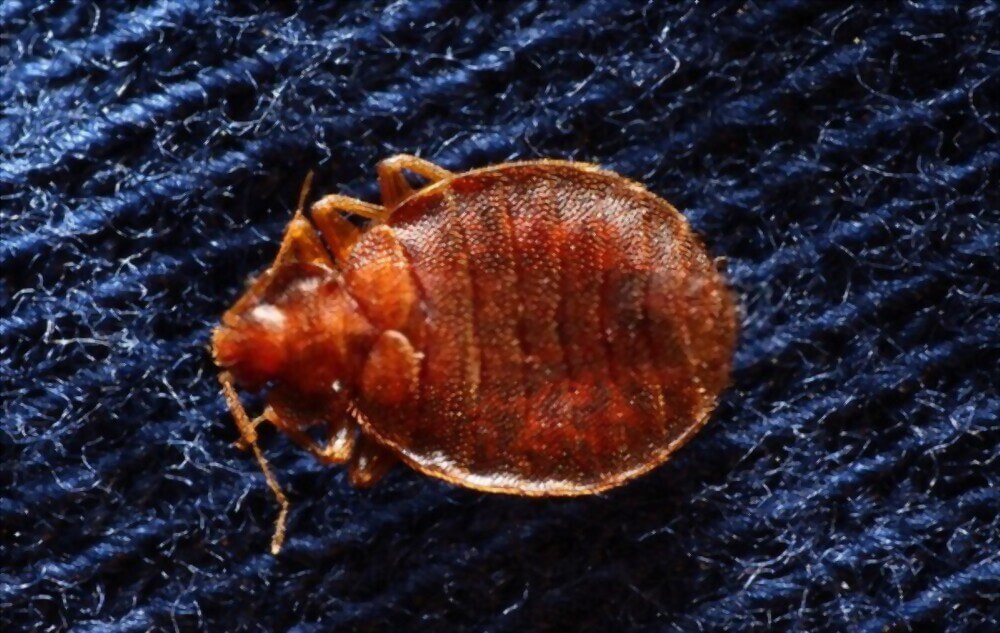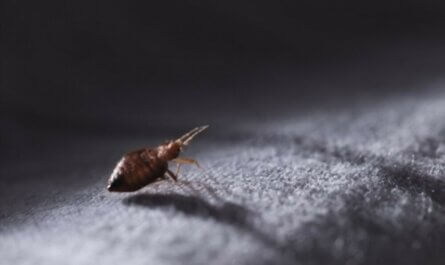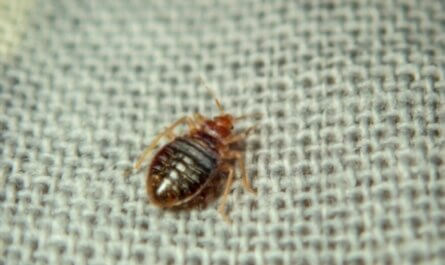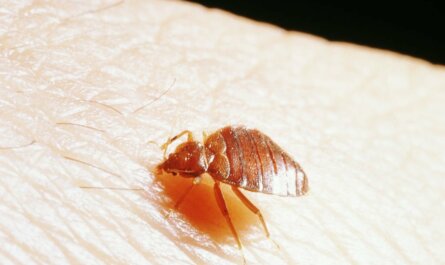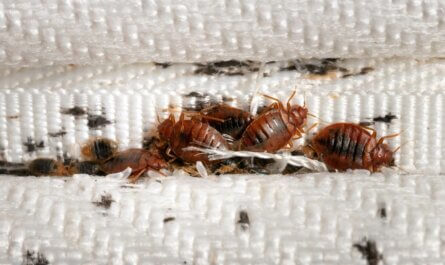Ever wondered what those mysterious little bugs that cause itchy bites in your bed might be? They could well be an infestation of bed bugs, a blood-sucking pest known to survive under extreme conditions.
This article provides you with a detailed guide on how to identify these tiny invaders based on their distinctive physical traits and characteristics. Are you ready to play detective in your own home? Let’s get started!
Key Takeaways
- Bed bugs have an oval – shaped body and are about the size of an apple seed.
- After feeding, bed bugs become elongated and balloon – like in shape.
- Bed bug eggs hatch into nymphs, which go through several molts before becoming adults.
- Physical characteristics such as flat bodies, oval shape, and reddish – brown color help identify bed bugs.
- Bed bugs can hide in mattresses, furniture, cracks, and crevices.
- Common signs of a bed bug infestation include bites on the skin, blood stains on bedding or furniture, and a musty odor in the infested area.
- Bed bugs can be distinguished from other insects like fleas or ticks based on their behavior and habitat.
Appearance and Life Cycle of Bed Bugs
Adult bed bugs have a flat, oval-shaped body and are about the size of an apple seed.
Size and shape of adult bed bugs
Adult bed bugs bear a striking resemblance to apple seeds in size and shape. They maintain an oval form, measuring about 0.3 inches long.
These insects are flat-bodied and devoid of wings, a characteristic that aids them in hiding within narrow cracks and crevices.
Upon feeding, their size can notably double, becoming more visible to the naked eye with a reddish-brown coloration indicating their satisfied state after a blood meal. The growth process from hatchling to adult involves multiple stages of shedding skin – termed as molting – where each stage sees an increase in the bug’s overall size until they reach adulthood.
Changes in appearance after feeding
Bed bugs undergo a dramatic transformation after feeding. Their normally flat, oval-shaped bodies become elongated and balloon-like as they fill with blood.
This process is quick – within 10 minutes of starting to feed, the bed bug will have doubled or even tripled in size! The color also deepens from a light brown to a darker reddish-brown.
Feeding activity has an impact on their behavior as well. After gorging themselves, bed bugs retreat back into hiding places for several days until hunger drives them out again.
Interestingly, they tend to congregate during this rest period which may be critical for reproduction and survival strategies.
It’s curious how such tiny creatures can exhibit complex behaviors depending on their nutritional status!
Life stages of bed bugs (eggs, nymphs, adults)
Bed bugs undergo various stages as they progress from eggs to adults. The fantastic journey begins when a female bed bug lays between one to five eggs per day, amounting up to 541 in its lifetime!
These minuscule white specks are about the size of a pinhead and hatch within ten days into nymphs.
Nymphs resemble their adult counterparts but lack fully developed sexual organs. This initial life stage goes through five molts before reaching maturity – shedding an old exoskeleton at every molt.
With each change, they take on more of the reddish-brown color associated with mature bed bugs.
However, nymphs require blood meals for these transitions, which is why growth may extend over weeks or even months depending on food availability and temperature conditions.
After approximately 21 days under optimal factors, nymphs metamorphose into full-grown bed bugs ready for reproduction themselves.
Identifying Bed Bugs
Bed bugs can be identified by their physical characteristics, such as their flat bodies and oval shape, as well as their color which is typically reddish-brown.
They are visible to the human eye and have small oval-shaped bodies.
Physical characteristics (flat bodies, oval shape, color)
Bed bugs have distinct physical characteristics that make them easily identifiable. They have flat bodies with an oval shape, similar to the size of an apple seed.
Their color can range from reddish-brown to a lighter shade if they haven’t fed recently.
Additionally, bed bugs have six legs and go through various life stages, including eggs, nymphs (young bed bugs), and adults.
Identifying these physical traits can help homeowners, renters, landlords, and pest control professionals recognize the presence of bed bugs in their homes or properties without any confusion or delay.
Where to look for bed bugs (mattresses, furniture, cracks, crevices)
Bed bugs can hide in a variety of places throughout your home. When inspecting for bed bugs, be sure to check the following areas:
- Mattresses and box springs: Look for any signs of bed bugs on the seams, folds, and crevices of your mattress and box spring.
- Furniture: Check the cracks, crevices, and upholstery of your furniture, including couches, chairs, and dressers.
- Cracks and crevices: Inspect walls, baseboards, and any other small cracks or crevices where bed bugs could potentially hide.
- Bed frames and headboards: Take a close look at these areas as bed bugs often nest behind or inside them.
- Gaps behind furniture: Don’t forget to check the gaps between furniture and walls, as bed bugs can easily hide there.
Common Signs of Bed Bug Infestation
Bed bug bites on the skin, blood stains on bedding or furniture, and a musty odor in the infested area are all common signs of a bed bug infestation.
Bed bug bites on the skin
Bed bug bites on the skin can cause various symptoms, including skin irritation, sores, itching, and an increased risk of skin infection.
These bites typically appear as small, flat or raised areas on the skin that may become inflamed, red, itchy, or even blistered.
The reactions to bed bug bites may not always appear immediately after being bitten.
They are often arranged in a rough line or cluster and can be found on the face, neck, arms, or any exposed parts of the body while sleeping.
If you notice swollen red spots that are itchy on your skin, it could be a sign of bed bug bites.
Blood stains on bedding or furniture
Blood stains on bedding or furniture are a common sign of a bed bug infestation.
These stains can be caused by blood from the bites or by bed bug excrement, and they may appear as small reddish-brown spots on sheets and pillowcases.
The color of the stains may vary depending on how fresh the blood or fecal matter is.
If you notice these dark spots on your bedding or furniture, it’s important to take immediate action to address the bed bug problem and prevent further infestation.
Musty odor in the infested area
The presence of a musty odor in an infested area can be a telltale sign of bed bug infestation. Bed bugs produce this smell through their feces, which contain iron that oxidizes and gives off a rusty smell.
Additionally, bed bugs release pheromones that have a musty-sweetish odor, similar to the smell of mildew or wet laundry.
This distinct odor is often not apparent unless there is an extreme infestation present.
So if you notice a musty smell in your home or any other area, it’s important to consider the possibility of bed bugs and take appropriate measures to address the issue promptly.
Bed Bugs vs. Other Insects
Bed bugs may be mistaken for other similar-looking insects such as fleas or ticks, but there are important differences in their behavior and habitat. Keep reading to learn how to distinguish bed bugs from other pests.
Similar-looking insects (fleas, ticks)
Bed bugs are often confused with other small, brown insects that can infest our homes like fleas and ticks. However, there are distinct differences between them.
| Insect | Appearance | Behavior | Habitat |
|---|---|---|---|
| Bed Bugs | Adult bed bugs are flat, oval-shaped, and reddish-brown. They have six legs, and their size ranges from 1 to 7 millimeters. | Bed bugs are nocturnal and feed on human blood. They typically hide during the daytime and come out to feed at night. | They prefer to live in dark, secluded areas like cracks, crevices, and folds of mattresses, box springs, and furniture |
| Fleas | Fleas are small, dark brown insects that are narrow-shaped. Their size range is 1.5 to 3.3 millimeters. | Fleas are active blood-feeders. They can jump up to 8 inches high to reach their host. | Fleas often infest furry animals and their habitats, including pets and wild animals. They can also infest human habitats. |
| Ticks | Adult ticks vary in color, depending on the species. They have eight legs and their size can grow up to 10mm when engorged with blood. | Unlike bed bugs, ticks remain attached to their host for a long period to feed. They pose a significant risk of transmitting diseases. | Ticks are commonly found in tall grass, wooded areas, and shrubs. They can also enter homes on pets or humans. |
These differences in looks, behavior, and habitat can help distinguish between bed bugs, fleas, and ticks. Recognizing these differences is crucial in addressing the appropriate pest problem.
Differences in behavior and habitat
Bed bugs exhibit unique behavioral and habitat preferences that differentiate them from similar-looking insects. Here’s a comparative study in a structured tabular format.
| Insect | Behavior | Habitat |
|---|---|---|
| Bed Bugs | Bed bugs are primarily nocturnal, feed on human blood, and their bites often result in itchy welts, although they do not transmit diseases. They do not build nests like other insects | Bed bugs are usually found hiding in mattresses, box springs, headboards, and baseboards. They are commonly found in homes, hotels, and healthcare facilities. |
| Fleas | Fleas are wingless insects that feed on the blood of mammals and birds. Their bites may cause itchy and painful red bumps. | Fleas are often associated with pets and are usually found in carpets, pet bedding, and upholstery. |
| Ticks | Ticks latch onto the skin of their hosts for feeding and can transmit various diseases, including Lyme disease. | Ticks prefer wooded and grassy areas and are commonly found on animals or humans who have been in such environments. |
| Cockroaches | Cockroaches are nocturnal insects that are omnivores, eating both plants and other insects. They are known to spread various diseases. | Cockroaches prefer warm, damp environments and are commonly found in kitchens, bathrooms, and near leaking pipes or appliances. |
| Carpet Beetles | Carpet beetles are scavengers that feed on a variety of items, including fabric, fur, and feathers. They do not bite humans but their larvae can cause allergic reactions. | Carpet beetles are commonly found in carpets, closets, and air vents. They can infest homes through cracks and crevices. |
How to Check for Bed Bugs
To check for bed bugs, inspect your mattresses, box springs, and bedding carefully. Look for tiny dark spots or stains on the sheets, which could indicate bed bug droppings.
Examine furniture and other hiding places like cracks and crevices for any signs of these pests.
It’s always a good idea to call a professional pest control service for confirmation and effective treatment options.
Read more to learn how to identify bed bugs and prevent infestations in your home.
Inspecting mattresses, box springs, and bedding
Inspecting mattresses, box springs, and bedding is crucial in checking for bed bugs. Here are some steps to follow:
- Flip over the mattress and examine both sides carefully for any signs of bed bugs.
- Check the seams, folds, and corners of the mattress as bed bugs often hide in these areas.
- Inspect the box spring by removing the dust cover and looking for any live or dead bed bugs.
- Examine the bedding, including sheets, pillowcases, and duvet covers, for rust – colored stains or dark spots.
- Use a flashlight to inspect the headboard and bed frame for any signs of bed bug activity.
- If you find any suspicious signs such as live bugs or fecal spots, consider calling a professional pest control service for confirmation.
Examining furniture and other hiding places
To check for bed bugs, it is important to thoroughly examine furniture and other potential hiding places. Here are some steps you can take:
- Dismantle the components of the bed, such as the headboard and frame, and inspect them closely for any signs of bed bugs.
- Use a flashlight to carefully examine cracks, crevices, and seams in furniture. Bed bugs are skilled at hiding in these small spaces.
- Inspect mattress seams, folds, and tufts for any signs of bed bugs. Look for dark spots or stains, which could indicate their presence.
- Check upholstered items such as chairs or sofas for any signs of bed bugs. Pay close attention to seams and underneath cushions.
- Examine other hiding places like nightstands, dressers, and closets where bed bugs may hide during the day.
Calling a professional pest control service for confirmation
If you suspect a bed bug infestation in your home, it is essential to call a professional pest control service for confirmation.
Pest control professionals have the expertise and experience to accurately identify bed bugs and assess the severity of the infestation.
They may use various techniques such as visual inspections, monitoring devices, or even trained dogs to detect these elusive pests.
Remember that bed bugs are adept at hiding in cracks, crevices, and furniture, making them difficult to spot with an untrained eye.
By relying on the knowledge and skills of a pest control service, you can receive an accurate diagnosis and develop an effective plan for extermination if necessary.
Don’t hesitate to reach out for professional assistance when dealing with a possible bed bug problem – their expertise can save you time, money, and frustration.
Bed Bug Prevention Tips
Clean and vacuum infested areas regularly, use mattress and furniture encasements, avoid second-hand furniture and clothing, and be cautious when traveling or staying in hotels.
Regularly cleaning and vacuuming infested areas
Regularly cleaning and vacuuming infested areas is crucial for preventing bed bug infestations.
By incorporating these practices into your cleaning routine, you can effectively eliminate bed bugs from your home or property. Here are some important tips to keep in mind:
- Use a vacuum cleaner with strong suction power to thoroughly clean mattresses, furniture, and other surfaces where bed bugs may hide.
- Pay special attention to cracks, crevices, and seams where bed bugs often reside.
- Empty the contents of the vacuum cleaner into a sealed bag immediately after use to prevent any escape or re-infestation.
- Consider using steam cleaning equipment to kill bed bugs and their eggs on fabric surfaces like mattresses and upholstered furniture.
- Practice good surface cleanliness by regularly wiping down hard surfaces with disinfectant spray or wipes.
- Remove any visible eggs you come across during your cleaning process to further reduce the number of bed bugs.
Using mattress and furniture encasements
Using mattress and furniture encasements is an effective way to prevent and control bed bug infestations.
Encasements are specially designed covers that make it harder for bed bugs to infest mattresses and box springs.
They create a protective barrier that prevents bed bugs from entering or escaping, ultimately helping to eliminate existing infestations and prevent new ones from starting.
You can find encasements specifically designed to protect against bed bugs at retailers or through pest control firms.
Using these encasements is a simple yet important step in controlling bed bugs and maintaining a pest-free environment.
Avoiding second-hand furniture and clothing
When purchasing second-hand furniture and clothing, it’s important to take precautions to avoid the risk of bringing home bed bugs. Here are some tips to help you prevent infestation:
- Inspect thoroughly: Before buying any used furniture or clothing, carefully inspect them for signs of bed bug infestation. Look for live bugs, exoskeletons, or dark spots that indicate bed bug droppings.
- Launder and dry: If you do buy second-hand clothing, wash them in hot water and dry them on high heat. This can help kill any bed bugs or eggs that may be present.
- Keep distance: When storing or displaying second-hand clothing, keep a distance between racks and walls or other furniture. This reduces the chances of bed bugs crawling from one item to another.
- Vacuum regularly: Regularly vacuum your rugs, floors, upholstered furniture, and cracks and crevices around the room. Dispose of the vacuum bag or empty the canister in a sealed plastic bag outside your home to prevent reinfestation.
- Use mattress encasements: Consider using mattress encasements that are specifically designed to protect against bed bugs. These covers create a barrier that prevents bugs from entering or escaping your mattress.
- Avoid clutter: Clutter provides hiding places for bed bugs, so keep your living spaces tidy and free from unnecessary items.
- Be cautious when traveling: When staying in hotels or using public transportation, be vigilant for signs of bed bugs. Keep your luggage elevated away from beds and upholstered furniture.
- Seek professional help if needed: If you suspect a bed bug infestation in your home despite taking precautions, don’t hesitate to contact a professional pest control service for thorough inspection and treatment.
Being cautious when traveling or staying in hotels
When traveling or staying in hotels, it is important to be cautious and take preventive measures against bed bugs. Here are some tips to help you protect yourself and your belongings:
- Inspect the room upon arrival for any signs of bed bugs, such as live insects, blood stains on bedding, or dark spots on the mattress.
- Use a luggage rack or place your suitcase on a hard surface rather than the bed or carpet to prevent bed bugs from hitching a ride.
- Keep your belongings in sealed plastic bags to minimize contact with any potential infestations.
- Before using the hotel room furniture, like chairs and couches, check for any signs of bed bugs hiding in the seams, cracks, or crevices.
- Avoid placing personal items such as clothing or bags directly on the floor or furniture. Instead, use hooks or hangers provided by the hotel.
- If you suspect a bed bug infestation during your stay, notify hotel management immediately and request a different room that is not adjacent to the infested one.
- After returning home from your trip, unpack your luggage outside if possible and inspect all items before bringing them inside. Wash clothes in hot water and dry them on high heat to kill any potential bed bugs.
Conclusion
In conclusion, bed bugs are small, flat insects with oval-shaped bodies. They can range in color from reddish-brown to a lighter brown depending on when they last fed.
Bed bugs have six legs and visible antennae, making them distinguishable as “true bugs.” It’s important to be aware of their appearance and characteristics in order to identify and prevent infestations effectively.
FAQs
How can I identify a bed bug?
Bed bugs are small, flat insects that are reddish-brown in color with oval-shaped bodies and six legs.
Are bed bugs visible to the naked eye?
Yes, bed bugs are visible to the naked eye although they are usually only about the size of an apple seed.
Where do bed bugs hide?
Bed bugs can hide in cracks and crevices such as mattress seams, headboards, furniture joints, and electrical outlets. They can also be found in luggage or clothing.
Do bed bugs leave any signs behind?
Yes, you may notice signs of a bed bug infestation such as tiny dark spots (fecal stains) on your bedding or furniture, molted skins from shedding nymphs, or itchy red welts on your skin caused by bites.
Can I spot bed bugs during daylight hours?
While bed bugs are primarily active at night when humans sleep, they can still be seen during daytime if you have a heavy infestation or disturb their hiding places.

